Kerala is a state that still follows certain customs and traditions in its own unique way. Its spectacular seasonal celebrations have always attracted tourists. Onam, the harvest festival of Kerala, celebrated in the first month of Malayalam calendar, has attracted attention from all over the world. Its colours, ways and traditional art forms have made it so popular. Kaikottikali to Thumbi thullal, Kaduvakali to Kummaatti Kali, Atham to Thiruvona sadya – Yes Onam is so special!
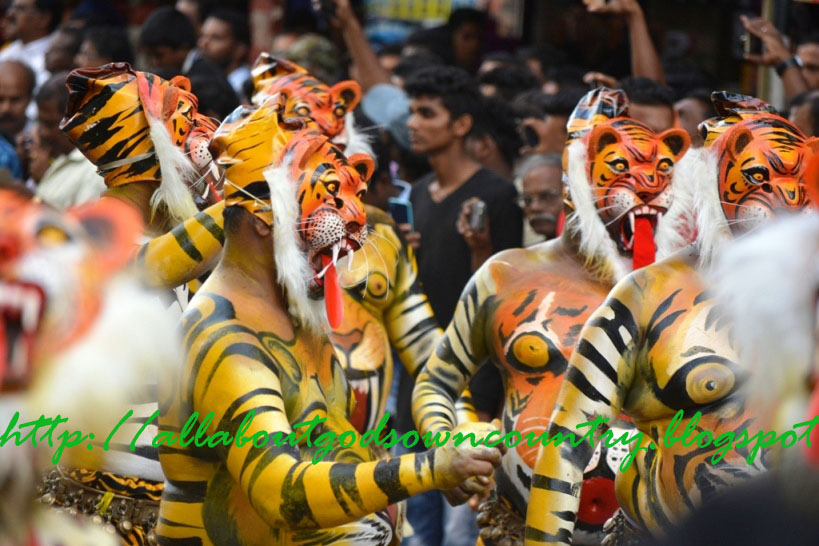 When the capital city of Kerala baths in colourful fled lights during Onam season, for Thrissur people, it’s Kaduvakali – their unique celebration of festival in vibrant form. When artists’ imaginations are pondered in yellow, black and red colours in the form on strips on participants’ body, not only does it gives a full percent entertainment package, but also welcoming the season in a unique tribal way. It gives a special treat to spectators’ eyes and minds as well as, cheers and warmness of this spring season.
When the capital city of Kerala baths in colourful fled lights during Onam season, for Thrissur people, it’s Kaduvakali – their unique celebration of festival in vibrant form. When artists’ imaginations are pondered in yellow, black and red colours in the form on strips on participants’ body, not only does it gives a full percent entertainment package, but also welcoming the season in a unique tribal way. It gives a special treat to spectators’ eyes and minds as well as, cheers and warmness of this spring season.
When participants disguised themselves in the form of tigers, leopards and hunters they dominate all the major streets and roads leading to Vadakkumnatha temple. In the temple maidan, it’s the royal feast which is associated with dancers among spectators as well. It seems as if tigers and leopards are coming from forests and playing Onam along with local people and hunters are trying to kill them. I forgot to tell you ‘Puli’ means leopard and ‘Kaduva’ means Tiger and hence this vibrant art form is known as Pulikali or Kaduvakali. While south Keralities call it as Kaduvakali, this art form is Pulikali for Malabaris, particularly Thrissur.
Why Thrissur is associated with Puli kali?
According to folklore beliefs, this art form was originated in Thrissur 200 years ago and later through popularization, it spread all around. Now, even in villages, we can see tigers and hunters playing around atha pookkalams on the 10th day – Thiruvonam just before Onam celebrations come to an end.
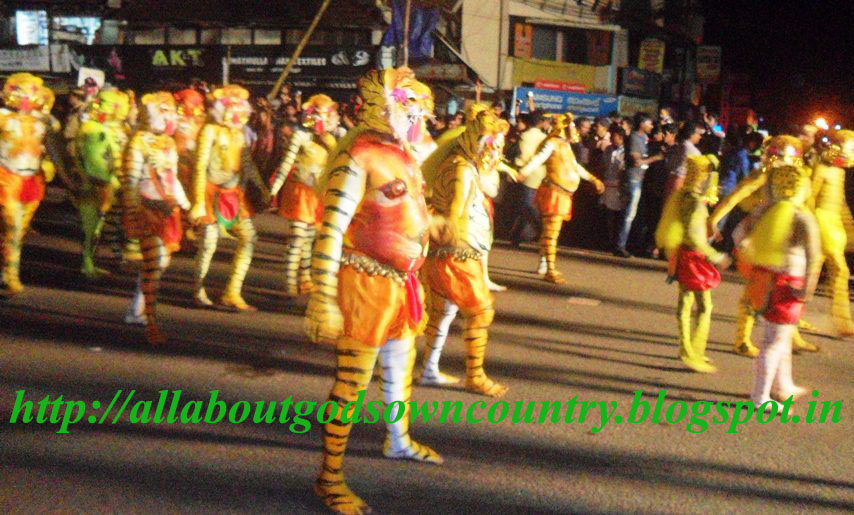
Before 200 years, Thrissur was under the direct rule of Shakthan Thampuran, the then ruler of Kochi. It’s believed that he wanted to bring some changes to Onam celebrations and wanted to introduce a new art form similar to dance form of animals and tribes. When animals were chosen, colourful animals – leopards and tigers got first preference. When Thrissur came under the control of British rule, Muslim soldiers popularized this art form by giving new steps and introducing hunters in the game. It was later called “Puliketti kali’. But this art form was accepted all over Kerala very soon, for its uniqueness, colours and fun associated with it.
Now Pulikkali is played on fourth Onam afternoon – Chathayam day in Thrissur, marking the end of celebrations in a colourful mode.
How Kaduvakali/Pulikali is conducted in Thrissur
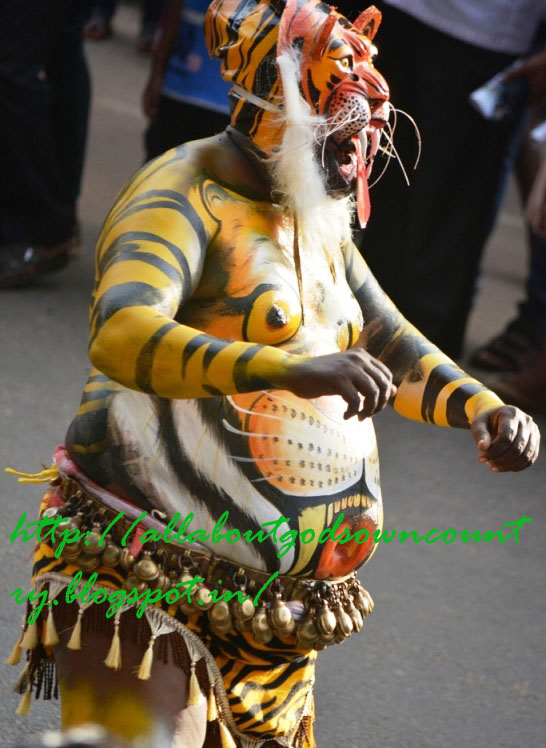
It’s tigers’ reign in the afternoon of Chathayam day – only male tigers, some child tigers too with the name Kuttipuli. People disguised as puli and kaduva, walk and dance towards the heart of main town from all the four directions and each group (sangham) will be representing a particular region known as ‘desam’. They are followed by hunters and people playing strange traditional instruments udukku and thakil. Now those instruments are very rare to see. Nowadays, chendamelam is also associated with pulikali – a change of trend that situation demanded.
Though it’s seen in sportsman spirit, best team, best tiger, best instrument and even the best disciplined tiger will be awarded with cash prizes. Teams belong to Poonthol desam, Viyoor desam, Mailupadam desam, Veliyannoor and Padinjaare nada. All these groups gather together at temple maidan where the grand feast is visualized. Tigers chasing goats and hunters running after tigers with guns and how tigers dance to escape from gun shots are really worth to see. Tigers gather at Ganapathy temple and break coconuts before entering temple maidan. It’s a custom followed over years.
Just two days before pulikali, a ceremony known as ‘Pulivaal Ezhunnallipp’ will be conducted every year and Chamaya pradarshanam – an exhibition of their accessories will be displayed by each desams.
A brief note on its extensive makeup
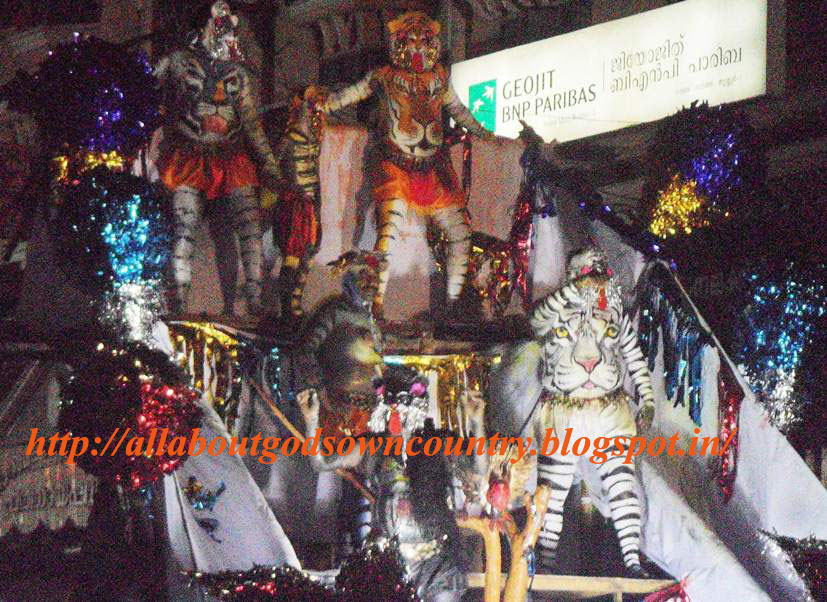
It’s a best method to exhibit your creativity and talents in colour blending. Very often artists use tigers’ pictures to draw their faces on bellies. Though it looks funny, it need 4-5 hours complete work to make a ‘ready-made’ tiger. Before starting the creativity, tigers need to remove their body hair, then apply first coat, wait for a few hours so that second coat and final touches can be given.
Enamel, varnish and even tempera powder are used taking patient 4 to 5 hours to make ready a tiger to play Onam. They normally use black, yellow, white and red shades to draw pictures on their belly. They fit a tiger mask also. It may cost more than 10,000 rupees to decorate a singer tiger. So, people used to collect funds from homes and organizations to accomplish the expenditure. Many season lovers are there who follow this tradition for more than 30 or 40 years, seeing it as a part of their culture. Their kids may follow them later.
Many positive changes over years
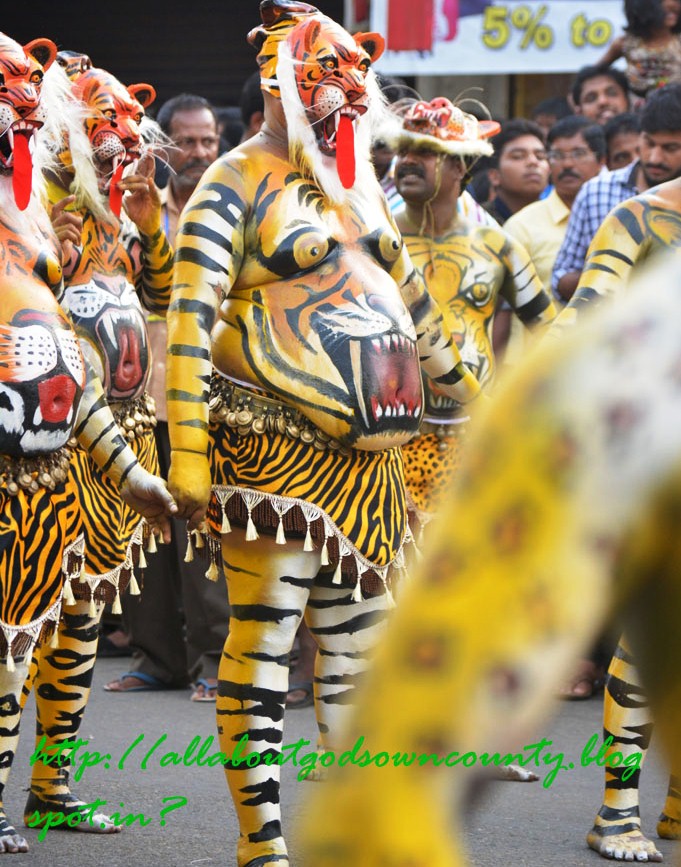 Earlier tigers with good physic were given preference. Now it’s the time for belly dancers. A little different from normal belly dancers! Performances need to have good bellies to dance along with thakil, udukk and the newly accomplished instrument of kaduva kali – chenda melam. Tigers and leopards tie bells around their waists as well to dance according to tunes – another reformation seen over years! Now it’s the time of masks, along with artificial teeth, tongue and many other accessories. But most important is the participation and its viewers and that, its popularity is growing every year with the passage of time. Nowadays tigers dance to the tunes of popular movie songs and albums as well. It’s really hilarious!
Earlier tigers with good physic were given preference. Now it’s the time for belly dancers. A little different from normal belly dancers! Performances need to have good bellies to dance along with thakil, udukk and the newly accomplished instrument of kaduva kali – chenda melam. Tigers and leopards tie bells around their waists as well to dance according to tunes – another reformation seen over years! Now it’s the time of masks, along with artificial teeth, tongue and many other accessories. But most important is the participation and its viewers and that, its popularity is growing every year with the passage of time. Nowadays tigers dance to the tunes of popular movie songs and albums as well. It’s really hilarious!
Yes, celebrations are always associated with some art forms, dances, funs and colourful displays. If Onam is associated with any such traditional art form, it’s sure Kaduvakali is given first preference and its absence during Onam season may look like a full moon sky without stars. Yes, this harvest festival is incomplete without this art form! Read to know about Kummattis of Thrissur
Go through the gallery to read a few more interesting articles on fun, recreation, myths and traditions associated with Onam season. Here is the page link. Click on the images to read.
 When the capital city of Kerala baths in colourful fled lights during Onam season, for Thrissur people, it’s Kaduvakali – their unique celebration of festival in vibrant form. When artists’ imaginations are pondered in yellow, black and red colours in the form on strips on participants’ body, not only does it gives a full percent entertainment package, but also welcoming the season in a unique tribal way. It gives a special treat to spectators’ eyes and minds as well as, cheers and warmness of this spring season.
When the capital city of Kerala baths in colourful fled lights during Onam season, for Thrissur people, it’s Kaduvakali – their unique celebration of festival in vibrant form. When artists’ imaginations are pondered in yellow, black and red colours in the form on strips on participants’ body, not only does it gives a full percent entertainment package, but also welcoming the season in a unique tribal way. It gives a special treat to spectators’ eyes and minds as well as, cheers and warmness of this spring season.

 Earlier tigers with good physic were given preference. Now it’s the time for belly dancers. A little different from normal belly dancers! Performances need to have good bellies to dance along with thakil, udukk and the newly accomplished instrument of kaduva kali – chenda melam. Tigers and leopards tie bells around their waists as well to dance according to tunes – another reformation seen over years! Now it’s the time of masks, along with artificial teeth, tongue and many other accessories. But most important is the participation and its viewers and that, its popularity is growing every year with the passage of time. Nowadays tigers dance to the tunes of popular movie songs and albums as well. It’s really hilarious!
Earlier tigers with good physic were given preference. Now it’s the time for belly dancers. A little different from normal belly dancers! Performances need to have good bellies to dance along with thakil, udukk and the newly accomplished instrument of kaduva kali – chenda melam. Tigers and leopards tie bells around their waists as well to dance according to tunes – another reformation seen over years! Now it’s the time of masks, along with artificial teeth, tongue and many other accessories. But most important is the participation and its viewers and that, its popularity is growing every year with the passage of time. Nowadays tigers dance to the tunes of popular movie songs and albums as well. It’s really hilarious! 

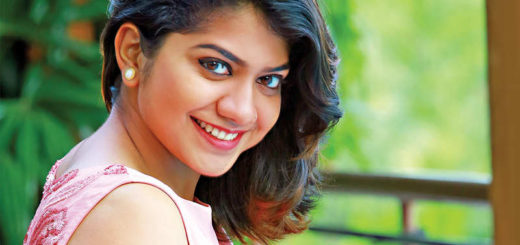

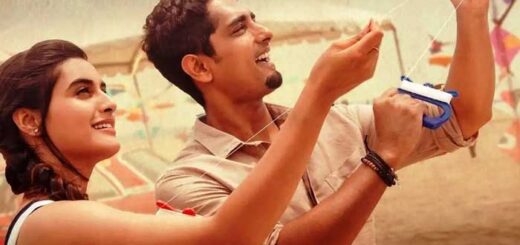








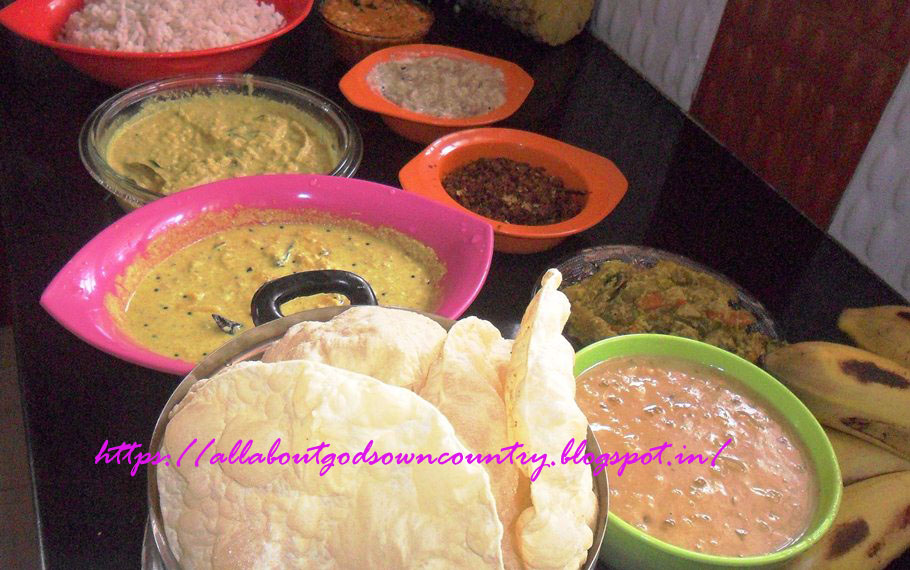
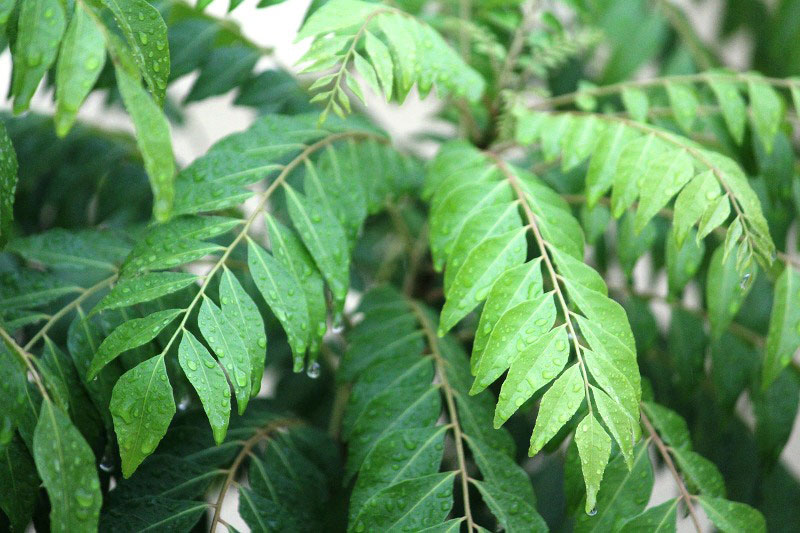
Recent Comments